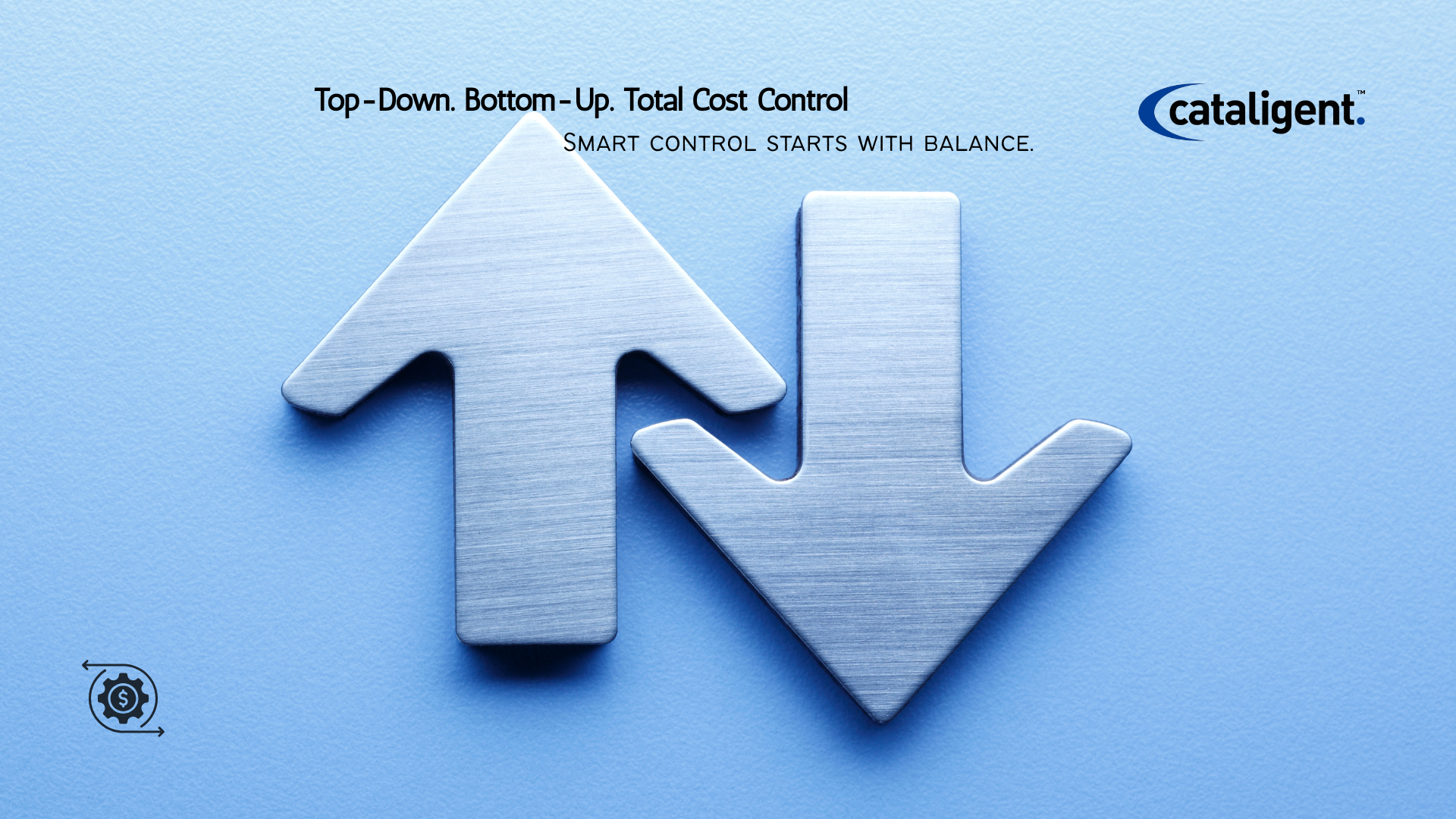What is Top-Down and Bottom-Up Targeting?
Top-down and bottom-up targeting is a dual methodology designed to achieve sustainable cost control by combining executive strategic goals with operational insights from the ground level. Top-down targeting involves leadership setting ambitious, organization-wide cost reduction objectives based on strategic priorities, budget limitations, and financial goals. Bottom-up targeting complements this by engaging operational teams, who provide practical validation, identify feasible savings opportunities, and ensure that targets reflect real-world constraints.
Cataligent applies this dual approach to bridge the gap between strategy and execution. By integrating top-down vision with bottom-up practicality, Cataligent helps organizations create cost control initiatives that are both ambitious and achievable, ensuring alignment between leadership expectations and operational reality.
Why the Dual Approach is Critical
Implementing a dual approach to cost control offers significant advantages for organizations seeking sustainable savings:
- Strategic Alignment: Top-down targets ensure that cost-saving initiatives directly support organizational objectives, enhancing the impact of financial management efforts.
- Operational Feasibility: Bottom-up validation grounds the targets in reality, making them achievable without overstressing teams or compromising performance.
- Employee Engagement: Involving operational teams in the goal-setting process fosters a sense of ownership, accountability, and active participation in cost-saving initiatives.
- Balanced Decision-Making: The integration of executive vision with operational input prevents unrealistic targets while promoting achievable, sustainable savings.
- Continuous Monitoring and Improvement: The dual approach enables ongoing evaluation, tracking, and refinement of cost-saving initiatives to ensure consistent progress over time.
Organizations that neglect either top-down or bottom-up approaches risk creating unrealistic targets or missing practical opportunities, potentially resulting in failed cost-saving initiatives and disengaged employees.
How Top-Down & Bottom-Up Targeting Shapes Cost Control Impact
Implementing this methodology ensures that cost control efforts are effective, measurable, and sustainable:
- Strategic Target Setting:
Cataligent works with executive leadership to define top-down cost reduction targets. These targets are derived from organizational budgets, strategic priorities, and financial performance indicators. Leadership input ensures that the cost control strategy is aligned with the broader vision and desired business outcomes. - Operational Validation:
Ground-level teams assess the feasibility of the top-down targets by analyzing operational processes, workflow efficiencies, and real-world constraints. Cataligent facilitates workshops, interviews, and data-driven assessments to gather insights from employees who are directly involved in day-to-day operations. This ensures that targets are practical, actionable, and realistic. - Alignment and Reconciliation:
Once top-down goals and bottom-up insights are collected, Cataligent helps reconcile any discrepancies between leadership expectations and operational realities. This process ensures that cost-saving targets are both ambitious and achievable, preventing overly optimistic or impractical objectives. - Implementation Planning:
Cataligent designs structured implementation plans that include detailed timelines, assigned responsibilities, resource allocation, and actionable steps. This systematic approach ensures that all levels of the organization understand their role in achieving cost control targets, promoting accountability and coordinated effort. - Continuous Tracking & Reporting:
Progress toward targets is continuously monitored using advanced dashboards, KPIs, and reporting mechanisms. Cataligent provides real-time visibility into savings initiatives, allowing leadership to identify bottlenecks, take corrective actions, and adapt strategies dynamically to changing conditions. - Sustainable Learning and Feedback:
Lessons learned from each iteration of cost control initiatives are captured and applied to future planning cycles. Cataligent ensures that the dual approach creates a feedback loop that fosters continuous improvement, building long-term cost-saving capability rather than one-off measures.
How Cataligent Can Help
Cataligent combines consulting expertise, structured frameworks, and advanced technology to implement a dual top-down and bottom-up cost control strategy:
- Strategic Planning Support: Collaborates with executives to define ambitious, achievable cost reduction goals aligned with organizational strategy.
- Operational Engagement: Facilitates bottom-up workshops, surveys, and data-driven analysis to validate targets and identify actionable savings opportunities.
- Actionable Implementation Roadmaps: Designs structured plans that translate targets into measurable, executable initiatives.
- Monitoring Tools: Utilizes dashboards, KPIs, and reporting systems to track savings progress, highlight risks, and provide actionable insights to leadership.
- Continuous Improvement: Iteratively refines targets, strategies, and processes based on performance data and feedback, ensuring long-term cost-saving capability.
Embedded Value for Organizations
- Achievable and Measurable Savings: Combines strategic objectives with operational reality to deliver practical, measurable results.
- Employee Engagement and Accountability: Involving operational teams fosters ownership and proactive participation in cost-saving initiatives.
- Strategic Alignment: Ensures that all cost control measures support business goals and long-term objectives.
- Enhanced Transparency and Control: Provides leadership with visibility and control over cost-saving initiatives, enabling timely interventions and adjustments.
- Sustainable Cost Management Capability: Builds a repeatable framework that promotes continuous cost optimization rather than temporary, one-off savings.
- Organizational Learning: Establishes a culture of data-driven decision-making, collaboration, and continuous improvement.
Top-down and bottom-up targeting offers a structured, balanced, and sustainable approach to cost control. Cataligent ensures organizations achieve ambitious savings while maintaining operational feasibility, employee engagement, and strategic alignment, creating a long-term framework for financial efficiency and performance excellence.

